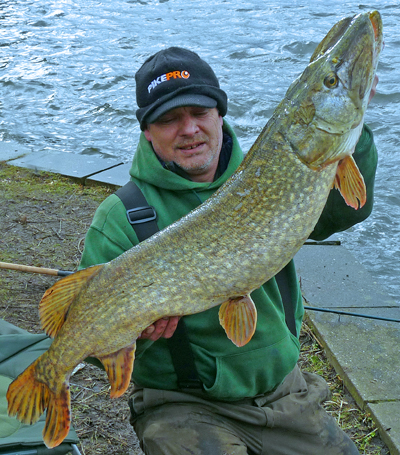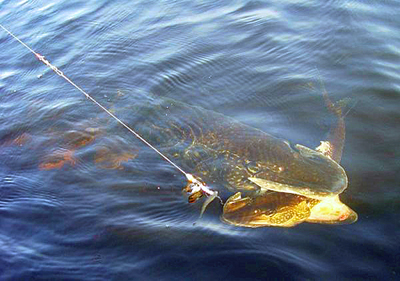I fished all season last year from October to March fishing waters from Cumbria to the Norfolk Broads and although I caught 55 doubles, I still only managed to catch one 20 pounder. This was a particularly unlucky season but it does demonstrate that 20s are rarer than you might think. Few pike will ever reach 20lb in their life time and not all waters can support pike of this size. So what makes a ‘monster pike’ of 30 lb and above and why are they rarely caught?
Waters occasionally throw up real monsters, indeed John Gobles hit the headlines with a huge 45lb 8oz record Broadland pike in 2009. This was a known fish but had still only been caught a few times during it‘s entire life, even though it was from a heavily fished water. Most very large pike are completely unknown until their capture late on in life. This throws up all sorts of questions such as how it lived so long without being caught? How it grew so big compared to pike in the same water and of the same age? We all have our theories so I thought I’d share some of mine.
Firstly, a water has to have a good and constant supply of suitable prey fish and the balance between predator & prey must be right. Hence why pike grow larger than normal in huge trout reservoirs where they prey are large, plentiful, high in protein and relatively easy to catch. The absence of anglers may also be an important factor here as pike fishing is generally restricted, which of course reduces angling pressure resulting in the fish being confident and therefore more likely to take a bait. Less fishing also means less risk of damage to pike by less competent anglers.
Very large pike are generally more solitary, avoiding busy or heavily fished areas so the chances of catching are vastly reduced. Some areas which are not accessible to anglers may be their preferred location.
Pike need only eat around 2 ½ times their body weight per year to survive. Most pike will eat more than this to suit the availability of food and it is likely that pike which have grown to enormous proportions will have eaten more or been less active. If we look at the maths, a 30lb fish may only be eating 75lb of fish per year. Due to it’s size it will be targeting larger prey of min. 2lb in size. If it eats 3 fish per feeding session, it only need feed for 13 days of the year, which equates to it only having to feed every 28 days. In reality it may eat more fish but when laying-up between feeds for a month it is likely to grab a few more passing snacks and this again reduces the amount of times that it has to go hunting. Depending on the amount of fish it can ambush while laying-up, it may not have to move far to feed for months. Perhaps another reason why it has grown so big and fat.
A pike’s diet consists on average of 25-35% of other pike. This is likely to be considerably higher for very large pike. It is almost unheard of for a pike angler to use a pike as bait and yet this is clearly the pike’s preferred food source.
To reduce the odds even further, pike will move seasonally to suit prey fish location and if disturbed could move a considerable distance. Just as you start to get to grips with locating big pike on a particular water, the goal posts suddenly move.
In conclusion; Big pike are very rare and the chances of finding them, offering the right size & type of bait, at a time when they are actively feeding is so slim that they are very seldom caught. Luck and many hours on the bank will play a major role but if you find a water which is likely to sustain a 30, you may fish for it for months and still not catch it. Even if lucky enough to drop a bait to the fish, it is unlikely to be at the right time for it to take it. Most pike anglers will never catch a 30 pounder, even the most experienced and dedicated.
Take from my theories what you will but this would explain why very large pike are exceptionally rare and seldom caught, even in waters where their numbers could be far higher than we think. Interestingly, many experienced pike anglers have developed similar theories over the years without conferring with one another. Perhaps these theories could also be applied to large fish of other species, which continue to avoid the angler’s net.
Tight Lines
Alan
Footnote: Alan Dudhill is regional organiser for the North Notts branch of the Pike Anglers’ Club of Great Britain. He also owns a tackle shop and Pikemaster tackle. You may contact him by email at alan@piketrace.co.uk
For tips on the safe handling and unhooking of pike, and much more, visit the PAC web site. Better still, join online and help fight to preserve our sport for future generations.



